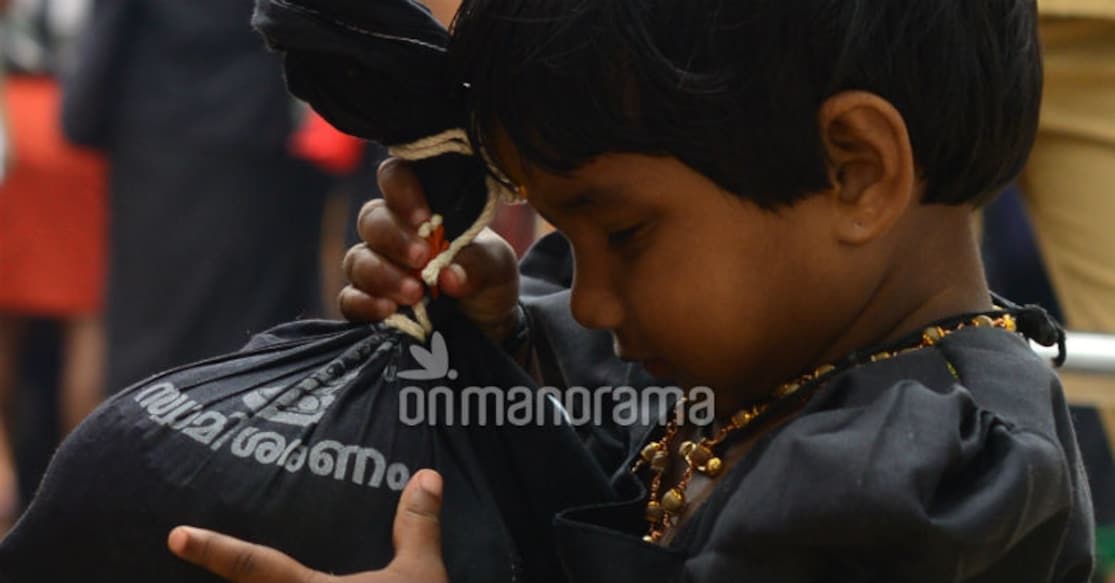A trip along the path to Sabarimala

Mail This Article
A pilgrimage to Sabarimala is not just one of piety and devotion. It is one of the most arduous treks that will test your endurance. There are customs and traditions to adhere to; rites and rituals that have to be observed. We take a trip through the pathways to the hill shrine. **The start** There are more than a couple of ways to reach Sabarimala. But the route through Erumely is the most popular one. Erumely, it is believed, is the place where Lord Ayyappa defeated the demon Mahishi. What makes a stop at Erumely special is the fact that the pilgrims are expected to offer prayers to Lord Ayyappa's lieutenant Vavar, who was a Muslim, at a masjid, which is right next to a temple dedicated to Ayyappa. In the olden days, people used to trek about 60 kms from Erumely through the jungles. The trip used to take them through Kalaketti, Azhutha, Kallidamkunnu, Mukkuzhi, Puthussery, Adivaram, Karimala, Valiyanavattam, Cheriyanavattam and reach Pamba. **Through the jungle** The first major stopover once a pilgrim starts from Erumely is at Kottapadi. According to popular belief, this is where Lord Ayyappa set up a fort to prevent wild animals from attacking his home town of Pandalam when he went in search of the tiger. Perurthodu, they say, is where the lord rested. The pilgrims who follow this path, rest here before they carry on to Erumboonikara. They offer prayers at both the temples at Erumboonnikara and it is from here that the forest, which form part of the Periyar Tiger Reserve starts. The next stop is at the Siva temple at Kalaketty, from here, Azhutha is two kilometers away. While taking a dip at Azhutha river the pilgrim is expected to pick up a stone. There is an Ayyappa Seva Sangham camp here, where food is served. Five more kilometers of steep climb takes one to Azhuthamedu, which is perhaps as difficult as climbing the Karimala. Further ahead is the Kallidamkunnu. The stone the pilgrim picked up at the Azhutha river is thrown here to commemorate the myth that the lord tied a rock before he threw the dead body of the Mahishi away. The climb, that began at Azhuthamedu tapers off at Enjipparakotta, which is a major resting point. The pilgrims can cook food here. The trip up to Kariyilamthodu through Puthsery and Mukkuzhi, a couple of pit stops, is a visual treat. The lush greens, the birds, and the sounds of the forest will calm you down. It is ideal to stop here and rest - for, just ahead of it lies Karimala. Karimala has eight levels, each more difficult than the other. Needless to say, the decent to Valiyanavattam is equally difficult. Camps are set up here during the season. Once, they cross over Cheriyanavattam, the pilgrims reach Pamba. Many pilgrims who come from far away places now start their journey from Pamba. **At Pamba** The pilgrims who reach Pamba worship Lord Ganesha, Nagaraja, Parvathi Devi, Aadimoola Ganapathi, Lord Hanuman, and Srirama Swami before starting on the trek to the shrine itself. You can either take the traditional Neelimala way or walk up the Swami Ayyappan road. Both are uphill all the way. **Sabaripeedam** Ayyappa devotee Sabari is believed to have attained 'Moksha' here. Pilgrims offer prayers, light incense sticks, rest and then walk uphill again. Once the pilgrim reaches Marakkuttam, the path diverges. If you are going to Sabarimala for the first time, it is ideal to take the Saramkuthi route even though it is steeper. You are expected to plant the bows you bring with you at Saramkuthi. This is symptomatic of Lord Ayyappa's final farewell to arms, and the adoption of non-violence as the way of life. From Saramkuthi, it is only a short walk to the temple

